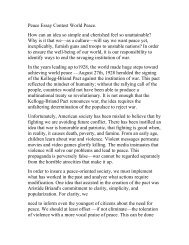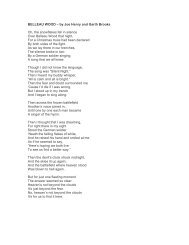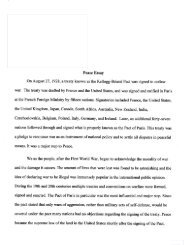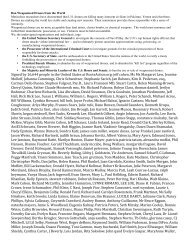US Training of Death Squads in Iraq? - War Is A Crime .org
US Training of Death Squads in Iraq? - War Is A Crime .org
US Training of Death Squads in Iraq? - War Is A Crime .org
Create successful ePaper yourself
Turn your PDF publications into a flip-book with our unique Google optimized e-Paper software.
www.uruknet.<strong>in</strong>fo?p=15949British “Pseudo-Gang” Terrorists Exposed <strong>in</strong> BasraKurt Nimmo, Another Day <strong>in</strong> the EmpireSeptember 20, 2005Baghdad Dweller reports two British soldiers held by “<strong>Iraq</strong>i authorities” <strong>in</strong> Basra (also describedas “Shiite militiamen” <strong>in</strong> the corporate media), and subsequently freed after the British stormed apolice jail, were work<strong>in</strong>g undercover as bombers. Baghdad Dweller <strong>in</strong>cludes a l<strong>in</strong>k to theWash<strong>in</strong>gton Post, where the follow<strong>in</strong>g appears: “<strong>Iraq</strong>i security <strong>of</strong>ficials on Monday variouslyaccused the two Britons they deta<strong>in</strong>ed <strong>of</strong> shoot<strong>in</strong>g at <strong>Iraq</strong>i forces or try<strong>in</strong>g to plant explosives.Photographs <strong>of</strong> the two men <strong>in</strong> custody showed them <strong>in</strong> civilian clothes.” The Herald notes thefollow<strong>in</strong>g: “Sources say the British soldiers, possibly members <strong>of</strong> the new SpecialReconnaissance Regiment formed earlier this month to provide <strong>in</strong>telligence for SAS operations,were look<strong>in</strong>g at <strong>in</strong>filtration <strong>of</strong> the city’s police by the followers <strong>of</strong> the outspoken Shi’ite cleric,Moqtada al Sadr,” thus admitt<strong>in</strong>g the soldiers worked undercover.The “Special Reconnaissance Regiment,” accord<strong>in</strong>g to Regiments.<strong>org</strong>, “formed with HQ atHereford from volunteers <strong>of</strong> other units to support <strong>in</strong>ternational expeditionary operations <strong>in</strong> thefight aga<strong>in</strong>st <strong>in</strong>ternational terrorism, absorb<strong>in</strong>g 14th Intelligence Company (formed foroperations aga<strong>in</strong>st Ulster terrorists), Intelligence Corps, and releas<strong>in</strong>g the SAS and SBS for the‘hard end’ <strong>of</strong> missions.” <strong>Is</strong> it possible the “hard end” <strong>of</strong> the “mission” <strong>in</strong> <strong>Iraq</strong> is to discredit theresistance and sow chaos <strong>in</strong> the country by front<strong>in</strong>g pseudo-gang terrorist groups (or the variant“pseudo-guerilla operations”), as the British have ample experience with elsewhere, notably <strong>in</strong>Kenya dur<strong>in</strong>g the Mau Mau upris<strong>in</strong>g and <strong>in</strong> Malaya? “Pseudo operations are those <strong>in</strong> whichgovernment forces disguised as guerrillas, normally along with guerrilla defectors, operate asteams to <strong>in</strong>filtrate <strong>in</strong>surgent areas,” writes Lawrence E. Cl<strong>in</strong>e for the U.S. Army <strong>War</strong> CollegeExternal Research Associates Program. “This technique has been used by the security forces <strong>of</strong>several other countries <strong>in</strong> their operations, and typically it has been very successful.” Indeed, onelong runn<strong>in</strong>g pseudo op, Gladio, was so successful it managed to render a nom<strong>in</strong>al Italianterrorist group, the Red Brigades (Brigate Rosse), <strong>in</strong>to an excuse (after proper <strong>in</strong>filtration byagents provocateurs) to <strong>in</strong>crease the power <strong>of</strong> reactionary forces <strong>in</strong> Italy and discredit socialist,communist, and even labor movements.The British SAS honed its “counter-<strong>in</strong>surgency” techniques <strong>in</strong> Northern Ireland and there is noreason to believe it has refra<strong>in</strong>ed from do<strong>in</strong>g so <strong>in</strong> <strong>Iraq</strong>. “Formed to perform acts <strong>of</strong> sabotage andassass<strong>in</strong>ation beh<strong>in</strong>d enemy l<strong>in</strong>es dur<strong>in</strong>g World <strong>War</strong> 2, the SAS evolved <strong>in</strong>to a counter<strong>in</strong>surgencyregiment after the war,” writes Sean Mac Mathuna. Mathuna cites a 1969 Army<strong>Tra<strong>in</strong><strong>in</strong>g</strong> manual (British Army Land Operations Manual, volume 3, counter-revolutionaryoperations) that enumerates several “tasks,” <strong>in</strong>clud<strong>in</strong>g:the ambush and harassment <strong>of</strong> <strong>in</strong>surgents, the <strong>in</strong>filtration <strong>of</strong> sabotage, assass<strong>in</strong>ation anddemolition parties <strong>in</strong>to <strong>in</strong>surgent-held areas, border surveillance … liaison with, and <strong>org</strong>anization<strong>of</strong> friendly guerrilla forces operat<strong>in</strong>g aga<strong>in</strong>st the common enemy.204








